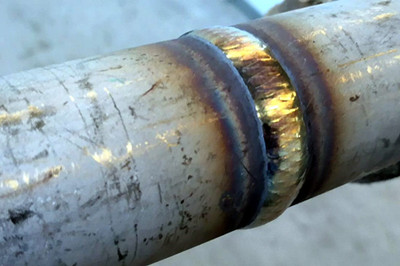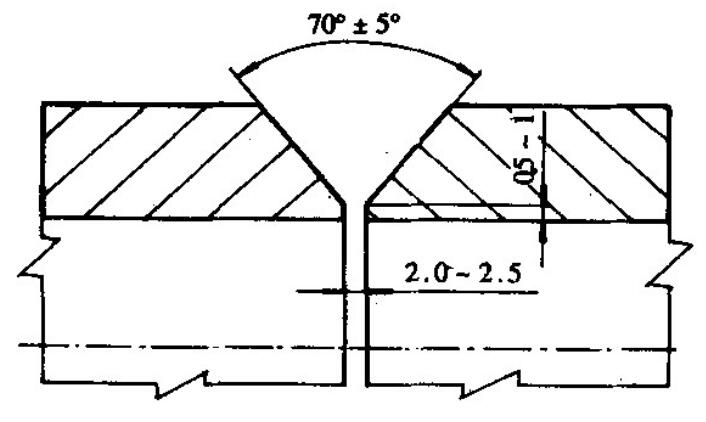316L UG pipes for transporting molten urea. The material is relatively rare in the country, there are no corresponding standard specifications, and it can only be supplied by welding in the foreign technical annex. The article on material properties, welding process, defects, testing and other aspects of 316L UG provides a detailed summary.

1. Introduction
In Chuanhua 1.2 × 10 4 A melamine project uses a UG 316L pipeline to transport molten urea. The pipe is grade 316L urea and its pipes, pipe fittings and welding consumables are supplied from abroad. Welding requirements are implemented in accordance with Italian Eurotecnica technical annexes. The difference from common 316L welded structures is that the welding test requires the ferrite content to be ≤ 1% after welding.
2. Analysis
2.1 Analysis of the corrosion resistance of the base material
Urea in 316L stainless steel Compared to common 316L, the chemical composition is similar (see Table 1). In urea and other media δ – Ferrite corrodes preferentially, resulting in selective corrosion; In addition to high temperature working conditions or multilayer welding, δ – Ferrite is converted to σ – Phase does not favor the base material's toughness and corrosion resistance. Therefore, to meet the requirements of special corrosion resistance (molten urea, etc.), it is necessary to strictly control the δ – Ferrite content of the base material and the weld seam.
The ferrite content of 316L UG service tubes is ≤0.6%, while the common ferrite content of 316L tubes has no special requirements.
2.2 Weldability analysis
Austenitic stainless steel has a low coefficient of thermal expansion and low thermal conductivity, welding shrinkage stress; austenitic stainless steel contains 5% -15% δ – Ferrite has sufficient guarantee of resistance to thermal cracking, while the δ – Ferrite content of UG 316L tube base material ≤ 0.6%, the requirement of weld δ – Ferrite content ≤ 1%. These factors make the weld more prone to thermal cracking, which is why appropriate precautionary measures must be taken during the welding process.
In the design, the selected welding consumables of type ER310LMo/BM310Mo-L meet the welding test requirements (see Table 2).
Table 1 1 UG Group 316L and 316L Material Comparison Table
| Metal material | component | |||||||||
| W | Mn | P | s | Yes | Cr | No | Mo | N | Ferrite content | |
| 316L | 0.02 | 0.84 | 0.03 | 0.005 | 0.47 | 16.75 | 12.19 | 2.31 | – | – |
| 316LU.G | 0.011 | 1.62 | 0.021 | 0.002 | 0.28 | 5:25 p.m. | 13.3 | 2.53 | 0.0665 | ≤ 0.6% |
Table 2: Welding material composition table
| Steel type | component | |||||||||||
| W | Mn | P | s | Yes | Cr | No | Mo | co | Ass | N | Ferrite content | |
| ER310LMo | 0.011 | 4.4 | 0.014 | 0.003 | 0.1 | 24.95 | 9:95 p.m. | 2.02 | 0.043 | 0.082 | 0.133 | – |
| BM310Mo-L | 0.03 | 4.53 | 0.018 | 0.006 | 0.44 | 24.53 | 21.19 | 2.39 | – | – | 0. 12 | ≤ 0.6% |
3.1 Preparation for welding made of UG 316L pipe
Construction sites must be clean to avoid contact between piping and carbon steel.
The grinding wheel can only be used to grind stainless steel. The wire brushes and tools used to remove welding slag are made of stainless steel.
Depending on the welding and grinding requirements of multilayer welds, chamfer preparation to increase the chamfer angle is suitable. For example, for ϕ 168.3 mm × 7.11 mm (6″ × 7.11 mm) (see Figure 1).

Figure 1: Bevel Diagram
Before welding, clean the chamfer on both sides of the 50mm area, the chamfer and wire must be cleaned with acetone.
The welding rods are used before baking at 250°C – 280°C for 2 hours.
3.2 Welding process parameters made of UG 316L pipe
- Electrical characteristics: manual argon arc welding – positive DC connection; Electrode arc welding – reverse DC connection.
- Tungsten electrode: tungsten material: cerium tungsten electrode; Tungsten electrode diameter: ϕ2.5mm; Nozzle diameter ϕ14 mm; Interlayer temperature: ≤100℃.
Table 3: Welding process parameters
| Sweat level | Welding process | welding material | Argon flow rate L/min | Welding current/A | Welding voltage/V | Welding speed cm/min | |
| Steel type | Diameter/mm | ||||||
| 1 | Manual argon arc welding | ER310LMo | ϕ2.0 |
Front 10 Back 6 |
90-95 | 18 | 5 |
| two | Arc welding with welding wire | BM310Mo-L | ϕ3.25 | Back 4 | 85-90 | 32 | 8th |
| 3 | ro welding Arc welding | BM310Mo-L | ϕ3.25 | Back 4 | 85-90 | 32 | 8th |
3.3 316L UG pipe welding process
Position welding and bottom welding manually, argon arc welding, fill welding and cover welding by electrode arc welding.
All welding work must be carried out under argon protection of the pipes, with argon purity ≥ 99.99%.
3.3.1 Position welding
- (1) Welds are made in three locations with a length of 10 mm each.
- (2) With a high-frequency ignition arc, the end of the tungsten tip is about 1-2 mm away from the beveled surface and the arc is kept short.
- (3) The position weld must be completely welded. For example, if cracks, porosity or other defects are found in the weld, the weld section must be ground and the position weld must be welded again here. No remelting is permitted for repairs.
- (4) Position the welding, left side ≯ 0.5 mm.
3.3.2 Floor welding
- (1) Wire feeding: The wire in the argon arc protection area moves intermittently back and forth in the weld pool, the wire feeding rhythm is somewhat fast and agile. During the welding process, the hot end of the wire should not be pulled out of the argon protection zone to prevent it from oxidizing and affecting the quality.
- (2) The welding torch must protect the weld pool with a delay of 20-25 s after the arc extinguishing.
3.3.3 Fill and cover welding
- (1) Rigorous cleaning of the intermediate layers; the welding process must be kept clean.
- (2) Strictly by interlayer temperature control requirements. A temperature pen can measure the temperature of the weld channel so that the interlayer temperature is below 100°C and then weld the next weld. Without a thermometer pen, you can also use portable temperature measurement to measure the non-hot solder channel.
- (3) Welding uses as much line power as possible and welds multiple layers and multiple channels (see Figure 2). Transport is carried out in a straight line and the bar must not be swung sideways.
- (4) After each welding process, emergency cooling measures such as welding water can be carried out, but the chlorine ion content of the water must be ≤ 25 ppm.
3.3.4 Cleaning after welding

Fig. 2 Schematic representation of welded connections
After welding, welding slag and paint residues must be removed and the surface lightened with grinding wheel, acid washing and brush treatment.
3.4 Common welding defects and preventive measures
3.4.1 Thermal cracks
Measures should be taken to reduce line power, use the welding channel with small cross-section, maintain the welding speed as high as possible, perform multi-layer multi-channel welding, and control the temperature between layers. Cooling is necessary after the last weld before welding the next to reduce weld overheating and improve thermal crack resistance. Close the bow slowly. The arch well must be filled to prevent thermal cracking of the arch well.
3.4.2 Lack of penetration welding
The blunt edge of the chamfer is too large, the root gap should be larger, the welding current should be larger, or the welding speed should be faster. This is easy to achieve and does not result in welding. Additionally, incorrect welding rods, wires and torch angles also lead to weld penetration.
During construction, the geometry of the welding groove must meet the welding requirements. When welding with low wire energy, the welding current should not be too low and the welding speed should not be too high. The welding process must be appropriate to ensure weld penetration.
3.4.3 Porosity
Before welding, the chamfer and both sides must be thoroughly cleaned to remove oil contamination. During the welding process, the argon flow must be adjusted to the appropriate value and it must be ensured that the surrounding air flow is not disturbed. The requirements for the electrode cooking process must be strictly adhered to. The welding electrode used for welding must be housed in a welding cylinder in which the electrodes have been baked.
3.4.4 Slag
(1) The slag on the surface of the previous weld has not been completely removed.
(2) Due to improper operation of the welding process, deep grooves are formed on both sides of the welding channel and the chamfer combination. During welding, the intermediate layers must be carefully cleaned and the grooves polished.
3.4.5 Severe oxidation of the weld surface
Before welding, oil contamination on the wire surface must be carefully removed. The welding process must be carried out with the lowest possible wire energy, the interlayer temperature must be strictly controlled and at the same time it must be ensured that the weld pool and the heated end of the wire are well protected from argon.
3.5 Check after welding
- (1) After visual inspection of the weld seam, the ferrite content is checked with a ferrite detector. A ferrite content ≤ 1% is considered tested.
- (2) Checking the ferrite content after passing X-ray inspection.
- (3) Weld seams (sleeves, corners, etc.) cannot be checked by X-ray. A color or ultrasound test must be carried out.

























































